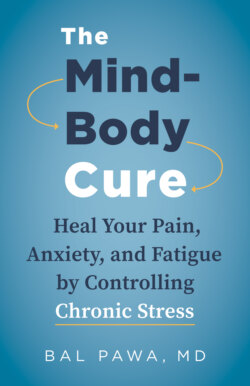Читать книгу The Mind-Body Cure - Bal Pawa - Страница 11
На сайте Литреса книга снята с продажи.
MIND MATTERS
ОглавлениеMost people use the terms “mind” and “brain” interchangeably. In fact, they are two related but very distinct entities. Our brain is an amazing organ with a definite shape, size, and function. It is three pounds of convoluted gray and white matter that looks like tofu and represents millions of nerve cells, nerves, and blood vessels. Humans used to think that only our species had a brain. We now know that many other species, from fruit flies to blue whales, have some kind of brain and nervous system to run their body. We also know that the shape and size of the human brain have changed over the millennia we have walked on Earth. For example, the frontal lobe of the modern human’s brain is remarkably larger and more developed than that of a Neanderthal human. Today, we view the brain as the control center for all our body’s actions. For example, when you accidentally touch a hot stove, the pain signals are communicated within a millisecond to the brain, you pull your hand away quickly, and further damage is controlled.
Our mind is more difficult to define because it is abstract. While most living things have a brain, the mind is harder to measure in other species. It is made up of concepts, beliefs, and individual perceptions based on our memories and experiences. The mind can evaluate situations, process information, and make decisions consciously or subconsciously. How do we x-ray someone’s mind? What does it look like? How big is it? Where is it located? The mind is a function of the brain but does not necessarily reside in the brain; the mind is the sense of awareness, consciousness, and intelligence that we all have. For example, imagine you say something on a whim that upsets someone, and you stop and think to yourself, “Why the heck did I say that?” Who is the thinker doing that reflective thinking? The observer of all the narration and thoughts that go on in the brain is the conscious mind, and the conscious mind is exclusive to humans (at least we used to presume it was).
In the 1800s, many intellectuals discussed whether specific areas of the brain controlled different parts and functions of the body, or if the whole brain integrating all of its various parts affected the entire body. A lot of discussion and research in this area was fueled by the case of Phineas Gage,1 a railroad foreman who suffered a brain injury in 1848. While he was directing a crew blasting rock to level the railbed, an iron rod pierced his skull on the left side just forward of the jaw, passed behind his left eye and through the left side of his brain, and then exited through the top of his skull. Extraordinarily, the young man’s life was spared. Before his head injury, Gage was described by people who knew him as a kind, sober, compassionate, moral, and friendly young man. After the accident, his friends and family observed a very different personality. He drank and became aggressive; he used profane language and became a belligerent jerk to all who came in contact with him. The man they once knew was gone. What is more surprising is that Gage recognized he was drastically different—he had an awareness and memory of his previous self—but could not control his behavior.
Scientists began to explore whether personality lives in the prefrontal cortex, the part of Gage’s brain that was pierced by the rod. Over a century passed before technology had developed enough that neuroscience could map out areas in the brain responsible for functions such as speech, physical movement, cognition, and memory storage. Scientists learned that the prefrontal cortex controls higher decision-making, personality traits, and judgment but not the awareness of self. Gage lost his inhibitions and his ability to filter emotions of right and wrong. He lost various personality traits, but the question remained whether he also lost his mind. Who was the observer in Gage’s brain that was “aware” he was behaving or thinking differently than before the accident?
